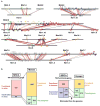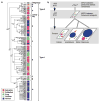Evolutionary dynamics of olfactory and other chemosensory receptor genes in vertebrates
- PMID: 16607462
- PMCID: PMC1850483
- DOI: 10.1007/s10038-006-0391-8
Evolutionary dynamics of olfactory and other chemosensory receptor genes in vertebrates
Abstract
The numbers of functional olfactory receptor (OR) genes in humans and mice are about 400 and 1,000 respectively. In both humans and mice, these genes exist as genomic clusters and are scattered over almost all chromosomes. The difference in the number of genes between the two species is apparently caused by massive inactivation of OR genes in the human lineage and a substantial increase of OR genes in the mouse lineage after the human-mouse divergence. Compared with mammals, fishes have a much smaller number of OR genes. However, the OR gene family in fishes is much more divergent than that in mammals. Fishes have many different groups of genes that are absent in mammals, suggesting that the mammalian OR gene family is characterized by the loss of many group genes that existed in the ancestor of vertebrates and the subsequent expansion of specific groups of genes. Therefore, this gene family apparently changed dynamically depending on the evolutionary lineage and evolved under the birth-and-death model of evolution. Study of the evolutionary changes of two gene families for vomeronasal receptors and two gene families for taste receptors, which are structurally similar, but remotely related to OR genes, showed that some of the gene families evolved in the same fashion as the OR gene family. It appears that the number and types of genes in chemosensory receptor gene families have evolved in response to environmental needs, but they are also affected by fortuitous factors.
Figures




References
-
- Ache BW, Young JM. Olfaction: diverse species, conserved principles. Neuron. 2005;48:417–430. - PubMed
-
- Adler E, Hoon MA, Mueller KL, Chandrashekar J, Ryba NJ, Zuker CS. A novel family of mammalian taste receptors. Cell. 2000;100:693–702. - PubMed
-
- Baxi KN, Dorries KM, Eisthen HL. Is the vomeronasal system really specialized for detecting pheromones? Trends Neurosci. 2006;29:1–7. - PubMed
-
- Berghard A, Dryer L. A novel family of ancient vertebrate odorant receptors. J Neurobiol. 1998;37:383–392. - PubMed
-
- Bjarnadottir TK, Fredriksson R, Schiöth HB. The gene repertoire and the common evolutionary history of glutamate, pheromone (V2R), taste(1) and other related G protein-coupled receptors. Gene. 2005;362:70–84. - PubMed
Publication types
MeSH terms
Substances
Grants and funding
LinkOut - more resources
Full Text Sources
